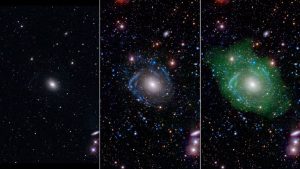The Making of a “Frankenstein” Galaxy

In optical light (left), UGC 1382 appears to be a simple elliptical galaxy. But when astronomers used ultraviolet and deep optical data (middle), spiral arms emerged. When it was combined with a view of low-density hydrogen gas (seen in green at right), scientists discovered UGC 1382 is bigger than expected.
NASA / JPL / Caltech / SDSS / NRAO / L. Hagen and M. Seibert
NASA / JPL / Caltech / SDSS / NRAO / L. Hagen and M. Seibert
We all know the story: a crazy scientist named Frankenstein creates a monster by assembling different human parts. Now, astronomers have found a similar “Frankenstein” galaxy about 250 million light-years away in a quiet and unremarkable neighborhood — butthis Frankenstein is beautiful!
The monster galaxy, UGC 1382, was originally thought to be old, small, and typical of other elliptical galaxies. Several surveys done in the 2000s looked for structural features like star rings and bars but didn’t find anything other than a simple elliptical galaxy. Then Lea M. Hagen (Pennsylvania State University) noticed something interesting about UGC 1382 when her team was investigating star formation in early-type galaxies.
Using NASA’s Galaxy Evolution Explorer (GALEX), which images the universe in ultraviolet, they noticed UGC 1382 had very extended spiral arms. Further investigation using optical and infrared light observations showed it was actually ten times bigger than previously thought and, unlike most galaxies, its innermost stars are younger than the stars on the outskirts. It’s almost as if the galaxy had been built using spare parts — like Frankenstein.
"This rare 'Frankenstein' galaxy formed and is able to survive because it lies in a quiet little suburban neighborhood of the universe, where none of the hubbub of the more crowded parts can bother it," said Mark Seibert (Observatories of the Carnegie Institution for Science) in a press release. The galaxy is so delicate that even a small nudge from a neighboring galaxy would make it disintegrate.
Frankenstein’s Formation
In most galaxies, the innermost region forms first and has the oldest stars. As time goes on, newer stars form in the outer regions of the galaxy. But this wasn’t the case with UGC 1382. Instead of a crazy scientist putting pieces together, this unique galaxy may have been the result of separate entities merging together — each with its own history.
First, a group of dwarf galaxies composed mostly of gas and dark matter formed. A rotating galaxy without spiral arms, called a lenticular galaxy, came together nearby. Then, at least 3 billion years ago, the smaller galaxies fell into orbit around the lenticular, eventually becoming its spiral arms. This process would make the center of UGC 1382 younger than the spiral disk surrounding it.
But Lynn Matthews (Haystack Observatory) says one has to be cautious with this scenario. It’s difficult to find the precise age of a galaxy because stars form at different times and that process doesn’t always go smoothly. The amount of heavy elements, or metallicity, present in the galaxy can also impact the ages of the stars. “What the authors have shown so far is intriguing, and new observations to measure metallicity of the stars and gas in the different parts of this galaxy would be a very interesting next step,” she says.
Finding Similar Galaxies
At about 718,000 light-years across, UGC 1382 is more than seven times wider than the Milky Way galaxy and, according to the study, is one of the three largest isolated disk galaxies known. The increasing availability of sensitive optical, ultraviolet, and hydrogen line observations of early-type galaxies may reveal more giant spirals like UGC 1382.
No comments:
Post a Comment